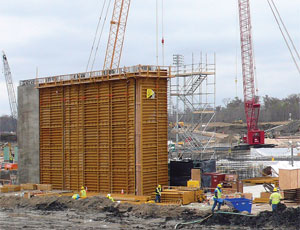Despite the gloomy construction employment climate, one New Orleans contractor has established a new safety and craft training facility and will hire several hundred people to bring its workforce to 1,000 by summer.

Gulf IntraCoastal Constructors, a joint venture of Kiewit Corp, Omaha, Neb., and Traylor Bros. Inc., Evansville, Ind., is gearing up to deliver the $854.8-million Gulf Intracoastal Waterway West Closure Complex, designed by the U.S. Army Corps of Engineers to protect from storm surge three parishes on the western side of New Orleans. “We’ll be at peak for about six months, beginning July,” says John Proskovec, GIC project manager. “We’re bringing people in from all over the country with the right experience.”
GIC broke ground on Aug. 6, 2009. It must deliver most of the project by June 2011, with wrap-up in 2013. Four key local subcontractors are already on the job, but GIC plans to have as many as 40 working as the job progresses.
The West Closure Complex consists of multiple, linked facilities. It is about 2.5 miles long and will have a finished elevation of 16 ft. Features include a 225-ft-wide sector navigation gate, sluice gates, about 4,000 linear ft of concrete T-walls, and another 300-ft closure segment still in design. There will be 1.5 miles of earthen levee as well as a pump station with 11 enormous pumps and a total capacity of almost 20,000 cu ft per second—the largest in the country.
Because the complex straddles both land and water, the JV capitalizes on Traylor’s “dam and floating experience” and Kiewit’s heavy-civil expertise, as well as its history of managing megaprojects with “lots of moving parts and pieces,” Proskovec says. “It’s a lot of work, fast.”
Kevin Wagner, Corps project manager, says progress has been marked by a number of milestones, including relocating an eastern perimeter road and excavating the pump station’s 141-ft x 560-ft footprint to 28 ft below sea level, driving 1,115 piles for the foundation, pouring foundation base slabs and forming and pouring the station’s western wall.
Additionally, GIC has driven 92 piles for the concrete monoliths that will brace either end of the sluice gates and completed a C-shaped cofferdam for sector- gate construction.
The project’s size and complexity has the Corps tapping design support from several districts, including Vicksburg, St. Louis and Rock Island.
The St. Louis District designed what it calls a “combi-wall” cofferdam and heavy-duty fender system. The brawny...


















Post a comment to this article
Report Abusive Comment